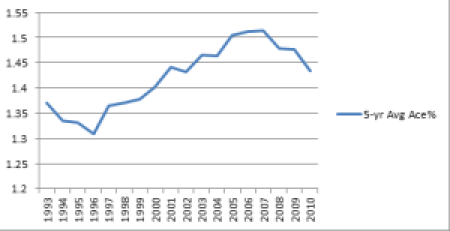Italian translation at settesei.it
Almost everyone agrees that the courts were slower at the US Open this year. The players thought so, the media concurred, and the tournament director confirmed that they had slightly changed the physical makeup of the surface in order to slow things down. Even clay-court wizard Dominic Thiem got within two points of the semi-finals, so clearly something changed.
I’m not going to argue with that. But when I set out to measure the change and get a sense of who might have benefited, I kept finding odd results. Almost nothing I tried revealed any clear-cut slowing of the surface, and by some metrics, the courts in Flushing played faster this year. Maybe it was just the heat and humidity–though the numbers don’t make that clear, either.
My usual starting point is my own surface-speed stat, which compares the ace rate at each tournament while controlling for the mix of servers and returners. While the dearth of advanced stats means it is limited to some basic inputs, it usually matches up quite well with our intution and doesn’t differ too much from Court Pace Index (CPI), an infrequently-available metric based on direct physical measurements. Using my algorithm, the US Open surface was 5% faster than the average surface at an ATP event in the last 52 weeks, compared to last year, when it was 4% slower. Compared to courts at the average WTA tournament, New York was 5% slower this year, versus 19% slower in 2017. The slowest tour-level surfaces (for either gender) have about 50% fewer aces than average, and the fastest have about 50% more.
2017 wasn’t just a blip, either in real-life on in my metric. It was similar to 2016, which also rated as considerably slower than this year’s surfaces. We’re left with a discrepancy that may stem from using an algorithm that relies too much on aces: Perhaps players were overwhelmed by the heat and tried more than usual to keep rallies short, or they simply didn’t bother trying to put their racket on first serves as often.
The evidence is clearer that players were more aggressive this year than in 2017. The average rally length, excluding double faults, on courts covered by Slamtracker (179 of the 254 main draw singles matches) fell from 4.28 shots last year to 4.17 this year, a drop of 2.6%. That could be affected by the changing mix of players in the draw (as well as those selected to play on higher-profile courts) so I isolated the 27 players with at least two matches worth of data from both 2017 and 2018. Those 27 saw their rally length drop a tiny bit more, about 3% from last year to this year.
We have the beginnings of an explanation. If players were showing more aggression–perhaps because the heat encouraged them to adopt more first-strike tactics–that could cancel out the effect of a slower surface. We can drill down even further using the Aggression Score (AS) metric, which measures the rate of winners and unforced errors per shot. Across all matches, AS rose from 15.3% in 2017 to 16.1% this year, an increase of 5.7%. Using the 27 players with multiple matches from both years’ tournaments, the difference is more stark, rising by 8.7%.
It’s clear that we saw more aggressive tennis at the 2018 Open than the year before. If we take for granted that the courts played faster, the case is closed: Tactics, probably heat-induced, outweighed surface. But if we approached the problem without knowing what players, media, and tournament officials said, the same numbers would unequivocally point to an even simpler conclusion, that the courts played faster.
If tactics explain our discrepancy, one more place we might look is first serves. Maybe servers took more chances, increasing their ace rate at the expense of first-serve percentage. But the data doesn’t back us up: The overall first-serve percentage in Slamtracker matches fell by a mere 0.07%. Using year-to-year comparisons for our set of 27 players, the difference was larger, but still a measly 0.3%. If tactics are the answer, it must be on the return of serve, not the serve itself.
This is where the trail runs cold. Return tactics are tougher to quantify than serving strategy, and there’s a limit to how much we can do with the available data. We can tally return winners and induced forced errors (IFEs), points in which the returner ended things with a strong reply. If returners allowed more aces, it should be because they took a more aggressive approach, trading fewer opportunities for better odds of winning when they did make contact. Instead, the record shows that return winners and IFEs fell a whopping 7% from last year to this year. That number supports the theory of a slower surface, and it meets expectations for those players who adopted very conservative return positions, such as Rafael Nadal, whose return winner/IFE rate went down by 3%, and Thiem, whose rate decreased by 7%. But a slower surface and a lower return winner/IFE rate should add up to fewer aces, not more.
Compared to where we started, we have a lot more data but not many more answers. Some signs point to a faster surface, others to a slower; some indicate more aggressive tactics, others more conservative ones. regardless of what we know about the physical makeup of the courts, there are many factors that influence what we refer to as “surface speed.” The hot, humid conditions in Flushing this year surely help complicate things–perhaps a study that took into account the heat index for each individual match would shed more light on these questions. We could also be seeing players adapt to the conditions–whether the heat or the slower surface–in different ways. Everyone may agree about how the courts played this year, but it’s much more difficult to pin down exactly what that means.





